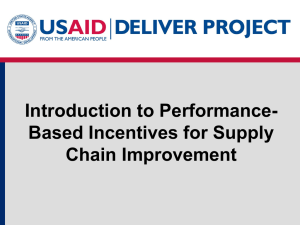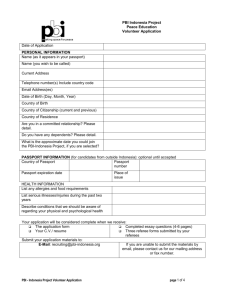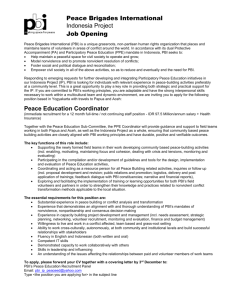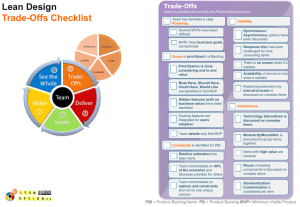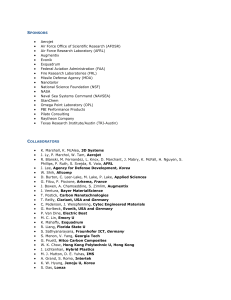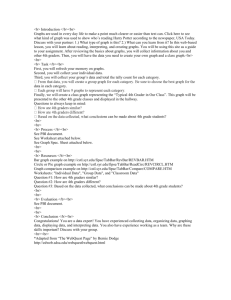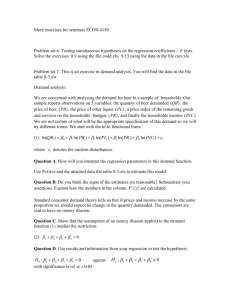Performance-Based Incentives for Public Health
advertisement
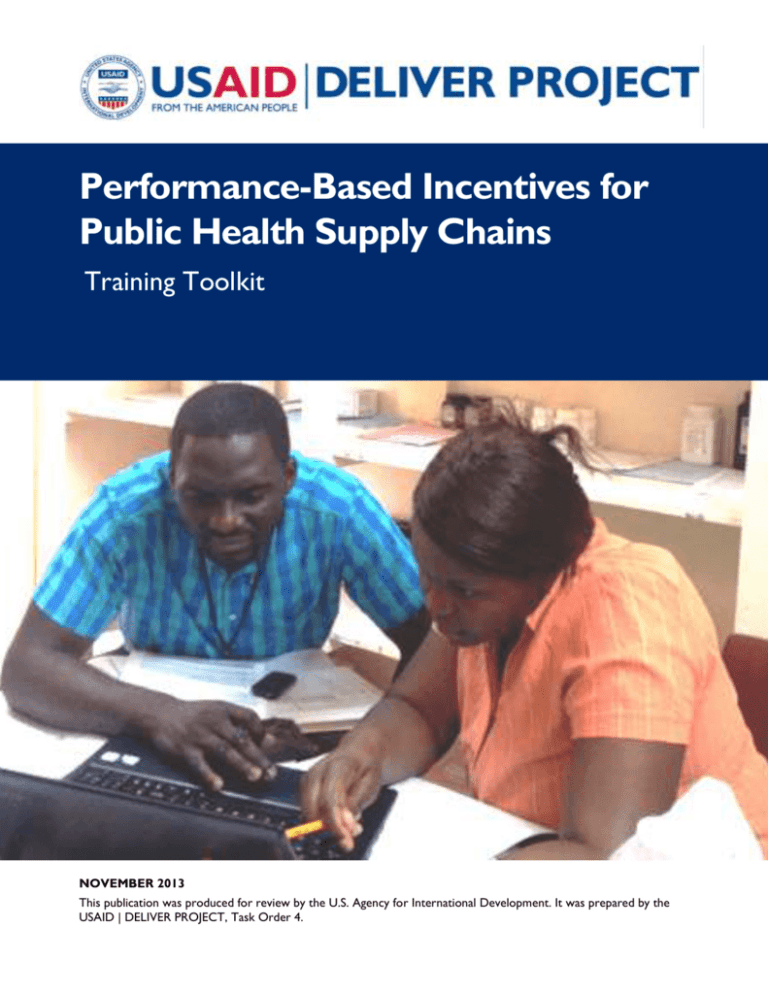
Performance-Based Incentives for Public Health Supply Chains Training Toolkit NOVEMBER 2013 This publication was produced for review by the U.S. Agency for International Development. It was prepared by the USAID | DELIVER PROJECT, Task Order 4. Performance-Based Incentives for Public Health Supply Chains Training Toolkit The authors' views expressed in this publication do not necessarily reflect the views of the U.S. Agency for International Development or the United States Government. USAID | DELIVER PROJECT, Task Order 4 The USAID | DELIVER PROJECT, Task Order 4, is funded by the U.S. Agency for International Development (USAID) under contract number GPO-I-00-06-00007-00, order number AID-OAA-TO-1000064, beginning September 30, 2010. Task Order 4 is implemented by John Snow, Inc., in collaboration with PATH; Crown Agents Consultancy, Inc.; Eastern and Southern African Management Institute; FHI360; Futures Institute for Development, LLC; LLamasoft, Inc; The Manoff Group, Inc.; Pharmaceutical Healthcare Distributers (PHD); PRISMA; and VillageReach. The project improves essential health commodity supply chains by strengthening logistics management information systems, streamlining distribution systems, identifying financial resources for procurement and supply chain operation, and enhancing forecasting and procurement planning. The project encourages policymakers and donors to support logistics as a critical factor in the overall success of their healthcare mandates. Recommended Citation Felling, Barbara, Brian Serumaga, James E. Rosen. 2013. Performance-Based Incentives for Public Health Supply Chains: Training Toolkit. Arlington, Va.: USAID | DELIVER PROJECT, Task Order 4. Abstract This training toolkit introduces the basics of performance-based incentive (PBI) schemes for the public health supply chain. It includes everything trainers need to conduct a training workshop, from a training PowerPoint and facilitator notes to a sample agenda and PBI flash cards. Cover photo: USAID | DELIVER PROJECT staff member Mubambe Kintu is reviewing the computerized LMIS monthly report for family planning commodities with Pharmacy Technician Christabel Mwila Katengulwa at Mwachisompola Demonstration Rural Health Center in Central Province, Zambia. September 2013. Photo credit: USAID | DELIVER PROJECT USAID | DELIVER PROJECT John Snow, Inc. 1616 Fort Myer Drive, 16th Floor Arlington, VA 22209 USA Phone: 703-528-7474 Fax: 703-528-7480 Email: askdeliver@jsi.com Internet: deliver.jsi.com Contents Introduction ........................................................................................................................................................................ 1 Facilitator Notes ................................................................................................................................................................ 3 Introduction to Performance-Based Incentives for Supply Chain Improvement .......................................... 3 Introduction to Performance-Based Incentives for Supply Chain Improvement ............................................. 23 Agenda ...........................................................................................................................................................................23 Checklist for Identifying Performance-Based Incentives Opportunities for Your Supply Chain .................. 25 PBI Cards ........................................................................................................................................................................... 27 Identifying Opportunities for Using Performance-Based Incentives to Improve Supply Chain Performance.......................................................................................................................................................... 33 Case Study ....................................................................................................................................................................33 Glossary of a Few PBI Terms........................................................................................................................................ 37 Resources for Performance-Based Incentives .......................................................................................................... 39 iii iv Introduction The USAID | DELIVER PROJECT has developed a short training module that introduces the basics of performance based incentive (PBI) schemes for the public health supply chain. You can use the module to train yourself or others on implementing performance incentives to strengthen supply chains. This module comprises eight items: A PowerPoint presentation with speaker notes can be used for self-paced learning. Facilitator notes will guide you through the entire training process. You can use the sample agenda to schedule the training session. Do not forget to have a look at the performance based incentives checklist. It presents ten preconditions that must be fulfilled to successfully implement PBI schemes that target supply chain improvement. The module also includes cards that list common PBI terminologies and their definitions. You can use the cards to start off a general discussion ("ice-breaker") at the beginning your training. The cards are supplemented by a glossary of terms. A list of further resources on performance based incentives is also included. Finally, the module offers a short case-study of one country where PBI has been used to improve supply chain performance. You can review the case study as a group or on your own to see if you can identify some options for PBI schemes in the supply chain. We hope you will find this module engaging, and that it will stimulate you to identify opportunities for PBI schemes in your supply chain. 1 2 Facilitator Notes Introduction to Performance-Based Incentives for Supply Chain Improvement Session Objectives: By the end of the session participants will be able to— 1. Define what is meant by performance-based incentives (PBI). 2. Identify possible benefits of PBI to management of health commodities. 3. Identify examples of how PBI has been used to improve supply chain performance—for both the commercial- and public-sector. 4. Identify opportunities for applying PBI to improve the performance of the participants’ supply chain, or for another supply chain in a given situation. 5. Identify sources of information/resources for learning more about PBI for supply chains, and how to design and implement a scheme. Time: 180 minutes Materials: PBI acronym cards Samples of different PBI resources (publications, website screen prints, Microsoft Excel printouts). Handouts: Glossary of a few PBI terms PowerPoint slides Checklist for identifying PBI opportunities for participants’ supply chain. Supply chain case study (see note to trainer) Resources for PBI PBI training session evaluation. PowerPoint Slides: 1. Session Title Slide 2. Icebreaker instructions 3. General definition of PBI 3 4. 5. 6. 7. 8. 9. 10. 11. 12. Session Objectives PBI in the Commercial Sector PBI in the Commercial Sector (cont.) Discuss with your neighbor (mid-PPT activity) PBI Lessons from the Commercial Sector PBI in Public Health Supply Chain Management PBI in Public Health Supply Chain Management (cont.) Other Potential Areas for Using PBI in the Public Sector Applying PBI – Small Group Assignment. Trainer Preparation: 1. Print PBI acronym cards on card stock and cut into individual squares. Place one card at each participant seat, or distribute to participants as they enter the room. Note to Trainer: Activity 3 assumes that participants are actively working in a supply chain, are providing technical assistance to a specific supply chain system, and are familiar with the management of that supply chain. It also assumes that more than one participant is familiar with any specific supply chain so participants may work in small groups or pairs. If participants identify PBI opportunities for their country supply chain, it would be helpful to have documents that describe the current state of that supply chain—including standard operation procedures manuals, recent LMIS feedback reports, results of recent assessments, etc.—readily available. If participants are not working in or are not familiar with a supply chain, give them the case study of a supply chain to use when they work through the exercise. Learning Activities Summary: 4 Title Type Time in Minutes 1. What is PBI? Icebreaker and discussion 25 2. Supply Chain Improvement through PBI: Public & Commercial Sector Interactive lecturette and presentation 30 3. Applying PBI for SC Improvement Lecturette, brainstorm, small group work; large group discussion 90 4. Learning More About PBI Pairs’ activity and presentation 25 5. Closing Interactive lecturette 10 Learning Activities: 1. What is PBI? Icebreaker and Introductory Lecturette: 25 minutes Tell participants to find a card at their place. Note that an acronym related to performance-based incentives or a definition is written on the card. Ask participants to find another person who has either the same definition or acronym card. When they do, they should— (facilitator display PPT slide 2) - introduce themselves - briefly discuss how the concept on the card could be used to improve supply chain performance - be prepared to introduce their new partner to the large group. After 10 minutes, ask pairs of participants to introduce themselves to the large group, name the term that brought them together, and tell the group the definition of the term. Note the range of terms; explain that in this workshop we will consider PBI in the broadest sense, showing the general definition of PBI (facilitator: show PPT slide 3). Cash or non-monetary benefit provided against measurable actions or achievement of a defined performance target 2. Distribute handout, Glossary of a Few PBI Terms—note that we just reviewed these terms. Review session objectives, PPT slide 4. Explain that we are now going to look at some examples of PBI in the public- and commercial sector, and continue the discussion on how PBI can help improve supply chain performance. Supply Chain Improvement through PBI : Public & Commercial Sector Interactive lecturette and presentation—30 minutes Ask participants if they have any direct experience with any form of PBI in their work in the field, or do they have examples from the private sector. Ask them to discuss them briefly. Present PPT slides 5-6 on examples of PBI in commercial, adding specific examples, as appropriate. Examples may include— - Sales-Based Performance Offers (SBPO): Buy one, get one free deals, commissions for selling tires to companies that run haulage fleets - Supply Chain Performance-Based Incentives (SCPBI): Airline engine suppliers - Gain sharing: Think symbiosis—e.g., contractual agreements for warehousing between phone distributors and mobile carriers. Show PPT slide 7: Ask participants to discuss with their neighbor for a few minutes, “What lessons can we learn from commercial-sector PBI that might benefit public health supply chain managers?” After several minutes, ask a few people to share some of their ideas. 5 3. Show PPT slide 8. Summarize the lessons. Show PPT slides 9–11. Present examples of PBI in public health supply chains. Note that the ideas on PPT slide 11 were developed during the USAID | DELIVER PROJECT and SCMS Supply Chain Strategic Leadership Summit. After reviewing the slides, ask participants to name any benefits that PBI can have to improve supply chain performance. Distribute handout and PPT slides. Applying PBI for SC Improvement Lecturette, brainstorm, small group work, large group discussion—90 minutes Note to Trainer: Choose the appropriate activity option based on the profile of the participants. If the session is incountry, or if participants are very familiar with a country specific supply chain, then participants can use the system they know to propose specific PBI activities for consideration. Participants should use their personal knowledge of their system for the activity. If participants are not familiar with a country-specific supply chain, they should use the case study example. Tell participants they are going to spend some time considering how they might apply PBI to improve the performance of their supply chain. Note that if they do not work in or are knowledgeable about a specific supply chain, they will work with a case study of a supply chain to identify ways to use PBI to improve performance. Distribute handout Checklist for Identifying PBI Opportunities for Your Supply Chain, and review the content of the checklist. Ideally, these conditions should be in place to make implementation of a PBI initiative more feasible. Tell participants to use this checklist to help guide their discussion. 6 Ask participants to brainstorm supply chain problems commonly found in public health supply chains. Write their answers on a flip chart; ask participants to name the problems that they are more likely to be able to address using PBI. Briefly discuss their ideas. Divide participants into small groups (up to 5 people) to work on the activity. If all participants are from or familiar with the same country, the facilitator can group them by level in the system, or by geographical location. If they are from several countries, group them in specific country groups. If participants are not actively working in or providing assistance to a supply chain, they can be randomly grouped. If applicable, give participant groups country-specific documents that describe the current state of the supply chain. Show participants PPT slide 12 and review the Small Group Assignment. Tell participants to use the checklist provided to identify several ways that PBI could be used to improve the performance of their supply chain. They have 45 minutes to complete the assignment. Note to Trainer: If you think the participants will need less than 45 minutes, add the following: “If time allows, identify indicators and targets to measure progress in solving the problem, and identify mechanisms to verify progress against the indicators.” Ask the groups to select a notetaker who will write down the discussion points to share with the larger group. After 45 minutes, ask groups to share their discussions and present Encourage participants to ask other groups questions and to offer ideas. Summarize and note that if they are working with a supply chain, they should continue to use this process beyond this session and to incorporate it into the work planning for their supply chain improvement. Explain that in the final activity of this session, they will consider some resources that could help them to take their ideas of using PBI to the next step. 4. Learning More about PBI Pairs/Trio Activity and Presentation—25 minutes 5. Ask participants to form a group with one or two other participants. Distribute to each pair/trio of participants one of the resources available on PBI—a publication, screenshot from a website, page from a Microsoft Excel spreadsheet, etc. Give the groups 5 minutes to quickly review the resource and prepare a two-sentence summary of how the resource can be used to learn more about PBI. After about 5 minutes, ask participants to volunteer to share their summaries. Distribute the handout, Resources for PBI. Note that the resources they looked at and others are listed here. Explain that these resources can be used as general background and to guide them in planning to how to design and implement a PBI scheme to improve supply chain performance in their countries. Closing 5 minutes Thank participants and ask if they have any remaining questions. Ask for initial feedback on the session. Distribute handout, PBI Training Sessions Evaluation. Ask participants to take a few minutes to provide their feedback on the session; we will use their comments to improve subsequent sessions. 7 8 Click here to download this PPT file from the USAID | DELIVER PROJECT website. 9 10 11 12 13 14 15 16 17 18 19 20 21 22 Introduction to PerformanceBased Incentives for Supply Chain Improvement Agenda Title Type 1. What are Performance-Based Incentives? Icebreaker and discussion 9:00–9:25 am 2. Supply Chain Improvement through PBI: Public & Commercial Sector Interactive lecturette and presentation 9:25–9:55 am Break Time 9:55–10:05 am 3. Applying PBI for SC Improvement Lecturette, brainstorm, small group work; large group discussion 10:05–11:35 am 4. Learning More about PBI Pairs’ activity and presentation 11:35–12:00 pm 5. Closing Interactive lecturette 12:00– 12:10 pm Lunch and complete evaluation 12:10–1:00 pm 23 24 Checklist for Identifying Performance-Based Incentives Opportunities for Your Supply Chain 1. The problem(s) with the supply chain have been clearly defined. 2. The underlying causes of the problem have been identified. 3. A logistics information system provides valid and reliable data. 4. A person or group of people who are responsible for the low level of performance of the supply chain can be identified. 5. The performance of the supply chain has been objectively evaluated or arrangements for an evaluation can be easily made (e.g., LIAT/LSAT). 6. The relationships between the different stakeholders and their responsibilities in the supply chain are clear (e.g., supervision arrangements, job descriptions, reporting schedules). 7. It is possible to set performance targets for groups working within the supply chain or between different levels of the supply chain. 8. Stakeholders can make changes in their work that will enable them to achieve the performance targets. 9. Performance targets are measurable and achievable within a given timeframe. 10. Funds for the reward are available or a substantial non-monetary incentive can be identified. 25 26 PBI Cards PBF Performance-Based Financing Cash or non-monetary benefit provided against measureable actions or achievement; often synonymous with RBF and PBI. 27 RBF PBI 28 Results-Based Financing Cash or non-monetary benefit provided against measureable actions or achievement; often synonymous with PBF and PBI. Performance-Based Incentives Cash or non-monetary benefit provided against measureable actions or achievement; often synonymous with PBF and RBF. P4P PBC Pay-for-Performance Payment for pre-determined performance target. Often synonymous with PBF, PBI, RBF. Often associated with healthcare delivery. Performance-Based Contracting Legal or formal agreement governing procurement of services. Three forms are— 1. contracting in 2. contracting out 3. management contracting. 29 PBG Performance-Based Granting Provides support for a recipient’s program versus PBC, which is procurement; an important distinction for USAID-funded activities. Output-Based Aid OBA 30 A subset of RBF or PBF, it uses donor aid as a financial reward to governments (or sometimes nongovernmental organizations for achieving outputs or outcomes. COD CCT Cash-on-Delivery Similar to OBA, but with emphasizes outcomes over outputs. Conditional Cash Transfers Cash provided to patients for use of specific services; e.g., immunizing children. 31 Performance-Based Agreement PBA 32 Synonymous with PBC. Legal or formal agreement governing procurement of services. Three forms are— 1. contracting in 2. contracting out 3. management contracting. Identifying Opportunities for Using Performance-Based Incentives to Improve Supply Chain Performance Case Study Instructions: Use the information below and the checklist provided to— 1. Identify one or more supply chain performance problems that you think a PBI initiative could be used to solve. 2. Review the checklist to determine the possibility of using PBI to address the problem. 3. If time allows, identify indicators and targets to measure progress in solving the problem, and identify mechanisms to verify progress against the indicators. 4. Prepare a brief presentation of the problem and how PBI could be used to address the problem. The Integrated Health Supply System of Anyland (IHSSA) provides essential medicines and program products to service delivery points (SDPs) nationwide using a storage and distribution pipeline operated by the Central Medical Stores, and managed in close collaboration with the Ministry of Health (MOH). See below for specific roles and responsibilities for supply chain partners, and details of the logistics management information system (LMIS) and the inventory control system, including a pipeline diagram. A recent quantitative and qualitative assessment of supply chain performance indicated that— Because of an insufficient supply of products, SDPs do not fully resupply community health workers (CHWs), which leads to frequent stockouts at the CHW level; 67 percent of CHWs had a stockout of at least one of the five tracer products in the three months prior to the assessment. Thirty-eight percent of SDP reports are received by the district after the 10th of the month; districts do not send SDP requests to the RMS if the Report and Request if the report is not received by the 10th of the month. Twenty-three percent of SDP reports submitted to the district are incomplete. More than 40 percent of stock cards at the SDP were out of date or had inaccurate stock balances. 33 Focus group discussions conducted during the assessment indicated that SDP staff do not fully understand the relationship between the data they report and the quantities of commodities they receive; therefore, they do not prioritize recording and reporting activities. They are discouraged when they do not receive sufficient quantities to serve their clients and to resupply the CHWs. “Even if we report on time, we don’t get what we need to serve our clients.” The lack of data has hampered the ability of the MOH program managers to work effectively with donors to identify resource requirements and develop supply plans. Several donors have committed to fund activities to try to solve the problems identified by the recent assessment; they have encouraged the MOH to take action quickly and to consider innovative solutions. Supply Chain Partner Roles: National Program Office (NPO): program management and monitoring, quantification, resource mobilization, policy Donors: funding for commodity procurement Manufacturers: product production, and sales and supply Wholesalers and procurement agents: produce procurement and supply Regional health office (RHO): program management and monitoring, policy enforcement District health office (DHO): supervisor, budget management, program management and monitoring Central Medical Stores: procurement, quality monitoring, storage and distribution to regional medical stores (RMS) RMS: storage and distribution to SDPs SDPs: serving clients, storage and distribution to CHWs CHW: serving clients, storage. LMIS: Stock data from CHW collected by SDP and consumption calculated; loss data not collected. CHW data aggregated into SDP report. SDP reports stock on hand, losses, consumption to DHO DHO reports SDP data to RHO, which then reports disaggregated data to NPO NPO aggregates data to use in quantification and procurement, and program monitoring Inventory Control System: Monthly forced ordering maximum-minimum between SDPs and RMS; SDP sends LMIS report and request form to district for budget approval before forwarding to RMS for resupply CHWs bring drug box to monthly meetings at the SDP; SDP staff do physical count and resupply, as possible. 34 Donors and Procurement Agents Manufacturers and Wholesalers Product Flow Central Medical Stores Disaggregated SDP Data from Districts Monthly Pull Regional Medical Stores National Program Office Report of Product Availability for CMS & RMSs SDP Specific Request for Health Products Regional Health Office Monthly Pull Disaggregated SDP LMIS Data Service Delivery Point SDP Monthy LMIS Report & Request District Health Office Monthly push Community Health Workers 35 36 Glossary of a Few PBI Terms Performance-Based Financing (PBF) Cash or non-monetary benefit provided against measureable actions or achievement; often synonymous with RBF and PBI. Results-Based Financing (RBF) Cash or non-monetary benefit provided against measureable actions or achievement; often synonymous with PBF and PBI. Performance-Based Incentives (PBI) Cash or non-monetary benefit provided against measureable actions or achievement; often synonymous with PBF and RBF. Pay-for-Performance (P4P) Payment for pre-determined performance target. Often synonymous with PBF, PBI, and RBF. Often associated with healthcare delivery. Performance-Based Contracting (PBC) Legal or formal agreement governing procurement of services. Three forms include— 1. contracting in 2. contracting out 3. management contracting . Performance-Based Granting (PBG) Provides support for a recipient’s program versus PBC, which is procurement, an important distinction for USAID-funded activities. Output-Based Aid (OBA) A subset of RBF or PBF that uses donor aid as a financial reward to governments, or sometimes nongovernmental organizations, to achieve outputs or outcomes. Cash on Delivery (COD) Similar to OBA, but with an emphasis on outcomes instead of outputs. Conditional Cash Transfers (CCT) Cash provided to patients for using specific services; e.g., immunizing children. Performance-Based Agreement (PBA) Synonymous with PBC. 37 38 Resources for PerformanceBased Incentives Publications Eichler, Rena, Alex Ergo, Brian Serumaga, James Rosen, Greg Miles, and Mavere Tukai. August 2012. Options Guide: Performance-Based Incentives to Strengthen Public Health Supply Chains – Version 1. Bethesda, MD: Health Systems 20/20 project, Abt Associates Inc. Eichler, Rena, and Ruth Levine. 2009. Performance Incentives for Global Health – Potentials and Pitfalls. London: Center for Global Development. Eichler, Rena, and Ruth Levine. May 2009. Performance Incentives for Global Health. London: Center for Global Development. Eichler, Rena, Barbara Seligman, Alix Beith, and Jenna Wright. March 2010. Pay-for-Performance in Family Planning: Lessons for Developing Countries. Bethesda, MD: Health Systems 20/20, Abt Associates Inc. Eichler, Rena, Barbara Seligman, Alix Beith, and Jenna Wright. September 2010. Performance-based Incentives: Ensuring Voluntarism in Family Planning Initiatives. Bethesda, MD: Health Systems 20/20 project, Abt Associates Inc. Health Systems 20/20, Abt Associates Inc. 2010. Performance-Based Incentives Primer for USAID Missions. Bethesda, MD: Health Systems 20/20, Abt Associates Inc. Serumaga, Brian, James Rosen, and Kevin Smith. 2012. Commercial Sector Performance-based Financing Offers Lessons for Public Health Supply Chains in Developing Countries. Arlington, Va.: USAID | DELIVER PROJECT, Task Order 4. Websites USAID|DELIVER PROJECT PBF website: http://deliver.jsi.com/dhome/whatwedo/commsecurity/csfinancing/csperfbasedfinancing Health Systems 20/20: http://www.healthsystems2020.org/section/topics/P4P Center for Global Development: http://www.cgdev.org/section/initiatives/_active/ghprn/workinggroups/performance World Bank: http://www.rbfhealth.org Contacts USAID | DELIVER PROJECT PBF Technical Leads: Brian Serumaga, bserumaga@jsi.com James E. Rosen, jrosen@jsi.com 39 40 For more information, please visit deliver.jsi.com. USAID | DELIVER PROJECT John Snow, Inc. 1616 Fort Myer Drive, 16th Floor Arlington, VA 22209 USA Phone: 703-528-7474 Fax: 703-528-7480 Email: askdeliver@jsi.com Internet: deliver.jsi.com

